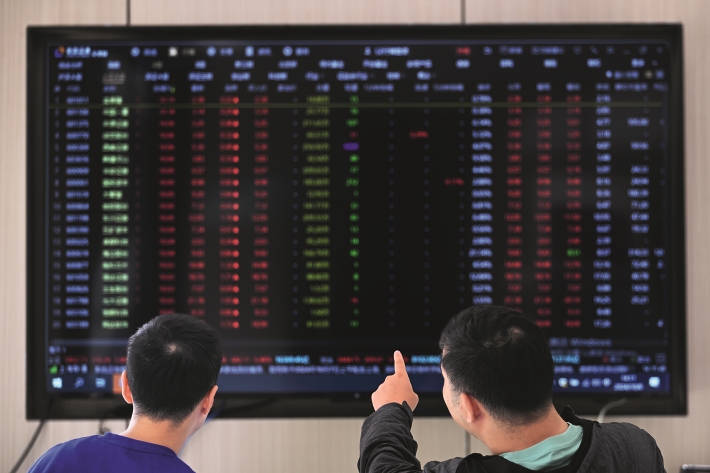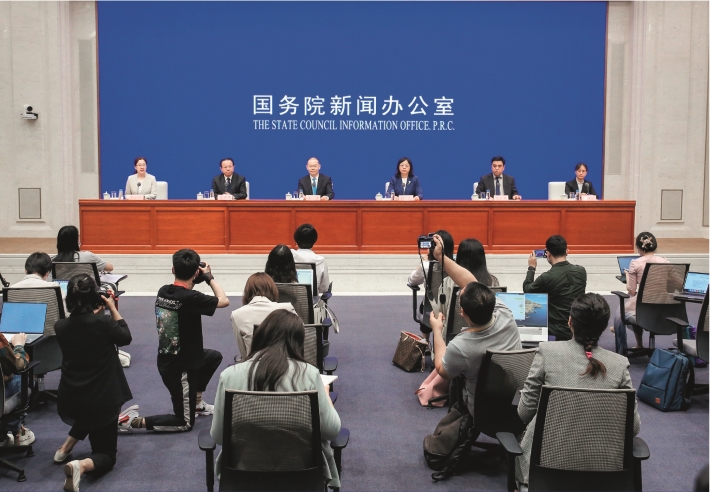|
||||||||||
| Home Top News Economy/Tech Culture/Sports China in Foreign Eyes Green Development Videos Intangible Cultural Heritages |
|
||||||||||
| Home Top News Economy/Tech Culture/Sports China in Foreign Eyes Green Development Videos Intangible Cultural Heritages |
| ChinAfrica |
| All-In, Buy China |
| A raft of new policies to stimulate the economy has strengthened market confidence |
| By Tao Xing | VOL. 16 November 2024 ·2024-11-08 |

People look at stock market trends at a securities trading office in Nanjing, east China’s Jiangsu Province, on 8 October (CNS)
China’s brokerages were busier than usual during the National Day holiday (1-7 October), providing round-the-clock online services for account opening and consulting after receiving requests from clients.
This investor enthusiasm was ignited by a strong rebound in China’s stock market right before the holiday. Fuelled by a series of stimulus measures announced on 24 September, the benchmark Shanghai Composite Index, an index of all stocks traded on the Shanghai exchange, gained more than 15 percent from 26 to 30 September, while the Shenzhen Component Index, a main index of the Shenzhen exchange, rose by more than 23 percent. The combined trading value at the Shanghai and Shenzhen exchanges hit a new single-day record of 2.6 trillion yuan ($370 billion) on 30 September. The market rally continued after the holiday, with the combined turnover of the Shanghai and Shenzhen bourses reaching 2.48 trillion yuan ($350 billion) on 8 October.
The upbeat sentiment about Chinese stocks was also felt abroad. The Nasdaq Golden Dragon index of US-listed Chinese stocks rallied 11 percent during the New York session on September 26, the biggest jump in more than two and a half years.
The investment narrative about China has also changed. Roughly one month ago, investment advisors were using the acronym ABC to connote “All But China.” That sentiment has turned around recently, and ABC now stands for “All-In Buy China.” In an interview with US business news channel CNBC on 26 September, US billionaire investor David Tepper said it’s a “buy everything” moment for Chinese stocks.
JP Morgan’s Asia Investment Strategy team wrote in an online report on 1 October that they are increasing their Chinese equity price outlooks and “shifting the strategic view from negative to neutral.”
Goldman Sachs has upgraded its outlook for Chinese stocks to “overweight.” Its strategists wrote in a note on the company’s official website on 5 October that Chinese equities may rise a further 15 to 20 percent.
Policy incentives
All this change is driven by a much bigger-than-expected policy package announced by China’s central bank, top securities regulator and financial regulator at a joint press conference on 24 September. The package includes a series of monetary stimulus efforts, property market support and capital market strengthening measures. These initiatives have reignited investor enthusiasm and bolstered market confidence in China’s economic recovery and high-quality development.
In terms of monetary stimulus, the People’s Bank of China (PBC), the country’s central bank, cut the reserve requirement ratio (RRR), or the portion of deposits that banks are required to keep in reserve and not lend out, by 0.5 percentage points on 27 September, following central bank governor Pan Gongsheng’s announcement at the conference.
The RRR cut freed up some 1 trillion yuan ($142 billion) of long-term liquidity that could be invested in the financial market.
To stabilise and revitalise the real estate sector, the PBC and the National Financial Regulatory Administration rolled out a number of policies on 29 September, as a follow-up action of the governor’s conference.
The mortgage rates for first homes, second homes and more are required to be reduced no lower than 30 basis points below the loan prime rate to ease financial burdens on property owners. The minimum down payment for housing mortgages will be lowered to no less than 15 percent for both first-home and second-home purchases.
According to Pan at the conference, the new policies intend to further reduce borrowers’ interest expenses, potentially benefitting 50 million households, or about 150 million people. The move is estimated to reduce total household interest expenses by approximately 150 billion yuan ($21 billion) per year on average, helping to boost consumption and investment.

Pan Gongsheng (second left), governor of the People’s Bank of China, Li Yunze (second right), head of the National Financial Regulatory Administration, and Wu Qing (right), head of the China Securities Regulatory Commission, attend a press conference in Beijing on 24 September (XINHUA)
Remaining confident
As Zheng Shanjie, chairman of the National Development and Reform Commission (NDRC) pointed out at a press conference on 8 October, China’s economy is facing difficulties.
The external environment is becoming increasingly complex and severe. International markets are facing volatility, global trade protectionism is on the rise and uncertain and unstable factors are increasing, all of which may negatively affect China through trade, investment and financial channels.
Major economies are experiencing weak growth momentum and heavy debt burdens, with many recently cutting interest rates.
Domestically, China’s economy is also under increasing downward pressure. Since July, major economic indicators, including industrial production, investment and consumption, have fluctuated. Some industries are looking at heightened competition, while others are struggling to adapt to the changes brought about by optimisation and transformation.
In a meeting on 26 September, the CPC Central Committee Political Bureau underlined the importance of taking a comprehensive, objective and clear-eyed view of the current economic situation, facing the difficulties squarely, and remaining confident.
“Remaining confident” is the overarching theme for China’s economic strategy, as also conveyed in two previous meetings held by the bureau this year.
The bureau’s meeting on 30 April stated that China’s economy still has a solid foundation, plenty of advantages, strong resilience and huge potential. It called for efforts to strengthen confidence in economic activities.
The meeting held on 30 July saw a focus on raising awareness of risks, preparing for worst-case scenarios and maintaining confidence in the country’s development.
The will to “remaining confident” is supported by the stable economic performance. The fundamentals of the Chinese economy remain unchanged, with favourable conditions such as a vast market, strong economic resilience and great potential, Zheng said at the press conference.
Bolstered by existing and newly introduced policies, market sentiment has improved, including a rise in the Purchasing Managers’ Index, an economic indicator that gauges activity in the manufacturing and services sectors, a warming stock market and robust consumption during the National Day holiday, Zheng added.
According to Zheng, a raft of reform measures conducive to economic development will be rolled out, which include the formation of guidelines on building a unified national market, and mechanisms to ensure increased investment in future industries.
With the gradual impact of newly introduced policies, China’s economic vitality will be further unleashed, market confidence will grow stronger and the foundation for high-quality development and stable economic performance will be further consolidated, Zhao Chenxin, vice chairman of the NDRC, said at the 8 October press conference.
China is confident in maintaining steady economic growth and achieving its full-year growth target of roughly 5 percent, Zheng told the press conference.
|
||
| About Us | Contact Us | Advertise with Us | Subscribe |
| Copyright Beijing Review All rights reserved 京ICP备08005356号-5 京公网安备110102005860号 |